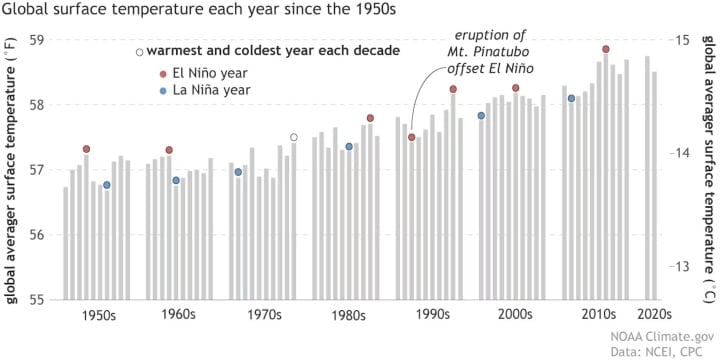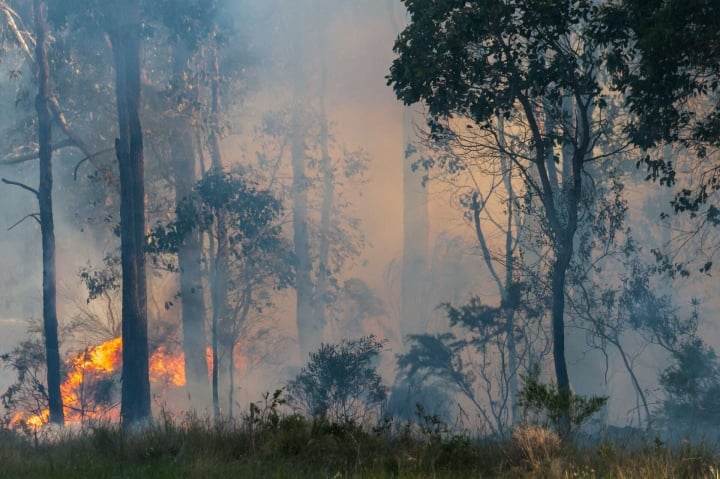According to the US National Oceanic and Atmospheric Administration (NOAA), the current La Nina cycle has lasted for 3 years, which is considered a rare occurrence (since 2020), but its cycle is gradually ending, along with the return of El Nino in the fall or winter of 2023.
With the return of El Nino, winds and sea surface temperatures in the Eastern Pacific will change and directly impact the global climate, even the air circulation in the Earth's stratosphere.
Because of El Nino's powerful influence on global rainfall and temperature patterns, scientists are closely monitoring the state of the tropical Pacific to provide early warning. However, there are also impacts that humans will inevitably face.

The hottest years on record were during El Nino events. (Photo: NOAA).
Earth's temperature increased by more than 1.5 degrees Celsius
When El Nino returns, the oceans begin to warm and transfer some of the excess heat and water vapor into the atmosphere. This further accelerates global warming and raises the average temperature of the Earth by at least 0.2 degrees Celsius.
The hottest year ever recorded by humans was 2016, which coincided with the strongest El Nino cycle.
Our planet has already warmed by about 1.2 degrees Celsius since pre-industrial times, so the return of El Nino will add even more heat to the atmosphere, so it is likely that Earth's average temperature will increase by more than 1.5 degrees Celsius during the next El Nino cycle.
However, scientists still cannot predict exactly how strong the impact of El Nino's return this time will be.
Heat, drought and fire
Scientists say Australia will be one of the first countries to feel the effects of El Nino's return. Less rain, higher temperatures and increased bushfire risk will hit Australia in winter 2023 and spring 2024.
Australia is currently about 1.4 degrees Celsius warmer than the rest of the world since the beginning of the 20th century due to global warming. The area of bushfires in Australia is also increasing every year.
Even with a three-year La Nina cycle that brings more rain, the impacts of climate change on Australia have not changed. So the return of El Nino puts Australia at new risk.

Heatwaves and bushfires could become more frequent and severe in Australia in 2023. (Photo: Metriognome).
Absorb CO2 slower
South America is considered to be the place where the effects of El Nino and La Nina have been known to humans, with Peruvian fishermen having known about them for centuries. Due to its location near the equatorial Pacific Ocean, South American weather is significantly disrupted when El Nino occurs, with flooding on the west coast of Peru and Ecuador, drought in the Amazon and northeastern South America, and widespread crop failures and drought.
During El Nino events, decreased rainfall and increased temperatures in Colombia have been linked to outbreaks of insect-borne diseases such as malaria and dengue fever. Higher temperatures during El Nino increase the rate at which mosquitoes reproduce.
Elsewhere during the El Niño cycle, the Amazon rainforest dries out and vegetation growth slows, so less CO2 is absorbed from the atmosphere. This phenomenon also occurs in tropical forests in Africa, India and Australia.
Winter is colder
The balance between high pressure over the Azores in the north Atlantic and low pressure over Iceland determines where in Europe it rains in winter - a belt of strong easterly winds that carries rain across the Atlantic will head north or south.
During El Nino winters, both pressure centers weaken and the air currents that bring wetter conditions to southern Europe disappear.
However, the biggest impact is seen in northern Europe, where winters are becoming drier and colder. An icy winter in 2023-2024 is possible if the El Nino cycle is strong enough by then. Due to global warming, scientists expect El Nino's influence on the North Atlantic and northern European winters to intensify.
Tra Khanh (Source: The Conversation)
Useful
Emotion
Creative
Unique
Wrath
Source




























![[Photo] National Assembly Chairman attends the seminar "Building and operating an international financial center and recommendations for Vietnam"](https://vphoto.vietnam.vn/thumb/1200x675/vietnam/resource/IMAGE/2025/7/28/76393436936e457db31ec84433289f72)







































































Comment (0)